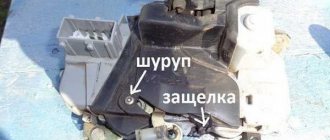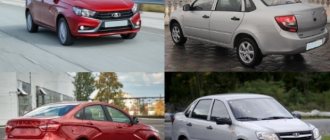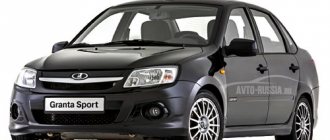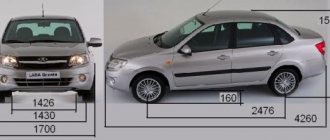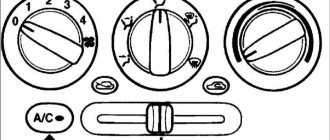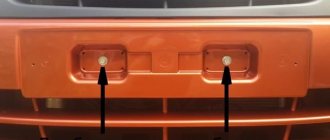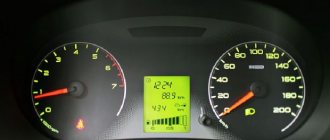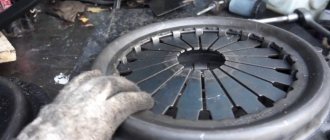After AvtoVAZ representatives began installing Isofix mounts in Vesta, motorists stopped using seat belts to secure child seats. You can now secure the device restraints using slide locks.
Author of the article: Roman Krasinets 04/14/2020 0 -1
Isofix in Vesta is a reliable fastener for a child seat, which is located on the rear “sofa” of the car.
Seat with a specially designed system for Lada Granta
Perhaps the safest will be a seat that meets international standards, according to which a child seat cannot be fastened using standard seat belts, but instead will be attached to the body through specially welded hinges. Such a seat was developed especially for the Lada Granta; the fastening system is called Isofix. For this type of seat, the Lada Granta is specially equipped with fastenings at the bottom, as well as an upper safety belt, which will allow any parent to install the seat without problems. The disadvantage of the system is its high cost; as a rule, chairs with Isofix are 2.5 times more expensive than regular chairs, and not everyone can afford it. But the question is whether it's worth saving on your child's safety.
The system itself consists of two levers that have a fixation point on the central and side rear seats, at the very junction of the backrest and the cushion. And the points for attaching the child seat belt are located behind the car seats. Symbols indicating specific mounting locations are located on the bottom of the rear seats and on each side of the seatback.
All child seats are sold complete with very detailed instructions in written and schematic form, so that anyone can handle the installation. The only thing is that all the fasteners and marks are made so that they remain as invisible as possible in the absence of a child seat, so you won’t be able to find some the first time, and after installation you should carefully study the instructions again and make sure that everything is secured correctly.
During installation, special attention should be paid to the intersection of the Isofix brackets and the seat belts, as the brackets can cause severe damage to the belts.
Why do you need ISOFIX in a car?
According to paragraph 22.9 of the Traffic Rules, the transportation of children in cars must be carried out strictly with the use of child restraint devices - car seats or boosters, which must be securely and correctly secured in the car.
There are two main ways to secure car seats - using a standard car seat belt or using the ISOFIX system .
car seats with a standard seat belt has a number of disadvantages, such as:
- complexity and ambiguity of fastening, which leads to the installation of a car seat with an error (and the statistics here are frightening - 8 out of 10 such seats, as a rule, are installed incorrectly!);
- lack of rigid fastening of the car seat, since when the belt is slowly tensioned, the locking mechanisms do not work and during sharp turns and smooth braking the car seat can rotate along the axis and move slightly in the longitudinal direction;
- during sudden braking, due to the lack of fastening rigidity, the car seat moves forward freely and begins to slow down only after the belt tensioners are activated, which leads to increased peak overloads for the child. In addition, this delta of movement is dangerous in the front seat when the airbag is deployed if it is not disabled;
- It takes much more time to install a car seat with a seat belt (to put it mildly) compared to a second fastening with an Isofix.
Fastening car seats using the ISOFIX is by far the most reliable and safe, since this fastening was developed by international experts to make the installation of child car seats quick, as simple as possible and the same in all cars. It’s not just that the ISOFIX fastening has been included in the basic equipment of foreign cars since 2006, and since 2011, all cars produced in Europe must have the ISOFIX fastening system. Modern models of domestic cars are also equipped with this system.
ISOFIX fastenings are paired metal brackets in the seat, welded into the car body (for the rear seats) or mounted into the metal frame / power frame (for the front seat). The distance between the centers of the two staples is 28 cm.
METHODOLOGY AND REMARKS
We install child seats as recommended by manufacturers of restraint systems and vehicles. We place the cradle seat of group 0+ facing forward, and the seat for older children (in the test a representative of group I) is “facing” forward. At the same time, we evaluate how convenient it is to install seats in a car: is the interior spacious, does the door open wide, is the doorway large, is the threshold high. We find out whether there are any difficulties when fixing the restraints - is there enough belt, is it easy to snap it into the lock, is it convenient to use Isofix.
Car seats with Isofix for groups 2 and 3
Numerous crash tests have shown that the Isofix mount is no longer suitable for a child weighing 15 to 20 kg. To secure it, you must use standard seat belts. They are threaded through special guides in the car seat. This is due to the fact that in the event of an accident, the load must fall on the belts, and the child and the seat must move forward. But very often, manufacturers offer mothers who are concerned about the safety of their beloved children to purchase chairs of categories 2 and 3. They also have Isofix mounts installed. What is it and can this device be used?
In fact, the so-called Isofix fastenings in this case are rather decorative. Or they serve to secure the seat in a car without a child. Real, power Isofix is not attached to seats of categories 2 and 3, as well as additional devices “anchor” or “leg”. This will only harm the child in an accident.
WHERE IS IT BETTER TO PUT A CHILD?
The traffic rules (clause 22.9) do not prohibit transporting children in the front seat. One condition is that the child must be seated in a child seat. However, remember that the risk of injury in an accident is higher for those sitting in front. And the safest places, according to statistics, are in the back seat, in the middle or behind the driver. Therefore, do not seat children forward unless necessary. By the way, not everywhere the rules for transporting children are as liberal as in Russia. In Germany, children under 12 years of age are prohibited from being transported in front, and in Israel they make concessions only for infants in bassinets. Therefore, when traveling with your family, find out what the rules of the country you choose require.
General instructions for installing ISOFIX brackets on the front passenger seat
If you plan to install the ISOFIX mount yourself on the front seat of your car, then below are general instructions on how to do this.
1) Purchase an ISOFIX bracket for your car model. The list of developed brackets can be found here.
It is important to understand that the ISOFIX bracket is a car part responsible for the safety of your Child in the event of an accident. According to the road transport safety standard, the brackets must be guaranteed to support a weight of up to 32 kg (including the car seat) at a peak load of 50 km/h. The ISOFIX brackets developed by our company are factory-fabricated from steel with a thickness of 3 mm and exceed the safety margin of the standard by several times.
ISOFIX bracket for NISSAN QASHQAI 2 | X-TRAIL (restyling) for the front seat
2) Remove the front seat from the car. To do this you need to: – move the seat as far back as possible, unscrew the 2 bolts; – move the seat forward as much as possible and unscrew two of the same bolts from behind the seat; – under the seat, disconnect the electronics chips (terminals), preferably first the heating and electric drive (if any), and lastly the airbag (usually the yellow wire); – in rare cases, it is necessary to unlatch the buckle of the car’s standard seat belt.
Example of electrical terminals for the front seat RENAULT KAPTUR
3) Place the removed seat on a comfortable, flat surface with the bottom up so that there is easy access to the back wall of the backrest and the side plastic pads.
4) “Try on” the ISOFIX bracket to the seat. To do this, you need to insert the bracket with square brackets at the back of the seat into the gap between the backrest and the seat. This fitting will intuitively tell you whether it will be necessary to remove the side plastic linings (in 90% of cases the linings will have to be removed).
Trying on the bracket on a SKODA OCTAVIA A7 without removing the side trims, attaching to the metal bottom of the seat with pre-drilling holes
5) If the bracket is designed for fastening to the load-bearing frame of the metal seat frame, it is necessary to provide access to the fastening elements. As a rule, these are either bolts holding the base of the seat back, hidden behind plastic covers, or bolts on guides that are screwed to the car body.
Trying on the INFINITI QX60 ISOFIX bracket with the side plastic covers removed. Attaching to the backrest base bolts
6) Unscrew the bolts from the load-bearing frame. Insert the ISOFIX bracket with the lugs with pre-prepared holes for the bolts into the frame elements, and screw the bolts back. As a rule, the bolts sit in nuts welded into the frame. Sometimes it is necessary to replace the standard bolts with similar, but longer ones (included with the brackets), sometimes the bolts need to be additionally secured with nuts with bushings (also included in the kit).
INFINITI QX60 ISOFIX mount. The bracket is tightened with a bolt of the load-bearing frame
Keep in mind that each bracket comes with installation instructions, which clearly indicate how the ISOFIX bracket should be installed!
7) After installing the bracket, reassemble the chair in the reverse order. Congratulations, now your seat is equipped with one of the most reliable, safe and simple systems for securing children's car seats!
IN PLACES
15th place “Mazda BT-50”
8 points
The pickup truck turned out to be the most unsuitable for transporting children, which, however, was expected. Due to the high seats, it is difficult to install the child seat either forward or backward. The door openings are narrow, especially the rear: only 450 mm. Moreover, this car is one of the most cramped in the editorial fleet. Even if a front passenger of average height moves close to the instrument panel, a child sitting in the rear in the direction of travel has only 230 mm of legroom left.
You don't have to install ISOFIX brackets yourself
To install Isofix fasteners, you can turn to specialists in their field - at ]ISOFIX-MSK[/anchor].
If a bracket is available, installation time for the front seat is from 40 minutes to one hour, for the rear seat up to 30 minutes. The work is carried out at the Buncar auto complex, which specializes in various services related to cars.
If your car is not on the list of developed brackets, we are ready to develop Isofix fasteners for the design of your seat!
We are glad to see you in our car complex!
TABLE OF EXPERT ASSESSMENTS
The table opens in full size with a mouse click.
Because You are not logged in. To come in.
Because you are not a trusted user (phone number is not verified). Enter and confirm your phone number. Read more about trusts.
Because The topic is archived.
i.e. you need 3 car seats back? what about the passenger in front? If so, then it's easy. I travel with 2 car seats in the back, so I can also have a passenger in the middle and even sit comfortably. On the same Skoda Rapid, the passenger can sit more closely under similar conditions, personally verified. Auto Kalina. ¶
Installing isofix in Lada Kalina
Viburnum is stuffed and stuffed. Just a foreign car. And when will they take care of such a detail as the possibility of attaching a child seat with Isofix? I am absolutely not happy with the snot on which my son's seat is attached. Such straps can hold a very small child, but my 20-kilogram child is unlikely. He even fidgets there and moves it from its place. What can be heard in VAZ’s plans on this topic. I have already written and will write again. I think this option is far from the most necessary. And in your case, even more dangerous:
The Isofix system also has disadvantages. During a hard impact, the rod is subjected to enormous loads, and its strength is not unlimited. Therefore, manufacturers of Isofix seats limit the weight of a child to 18 kg: car seats of the second and third groups with Isofix fastening simply do not exist. In addition, the ECE R 44/04 rule limits the weight of the seat itself to no more than 15 kg. Test of the magazine "AutoReview" (2006, No. 11)
Smitn, not at the moment.
Although the OM states that it exists, and there are no references to a variant design, that is, it seems like it’s already available everywhere. I have an RE dated October 2011.
Upwelling, My post is dated May 13th, at that time there was no...

